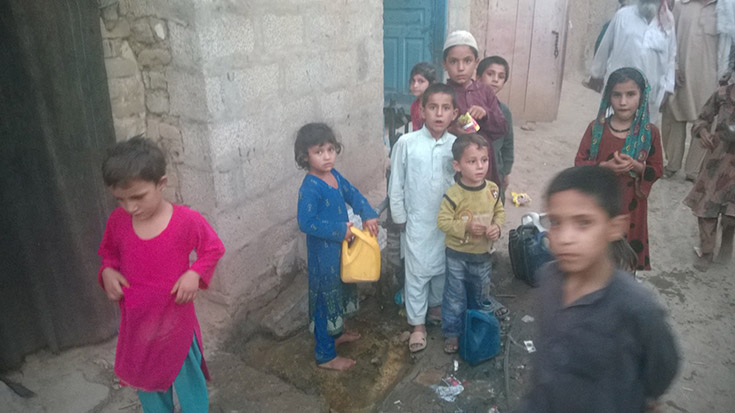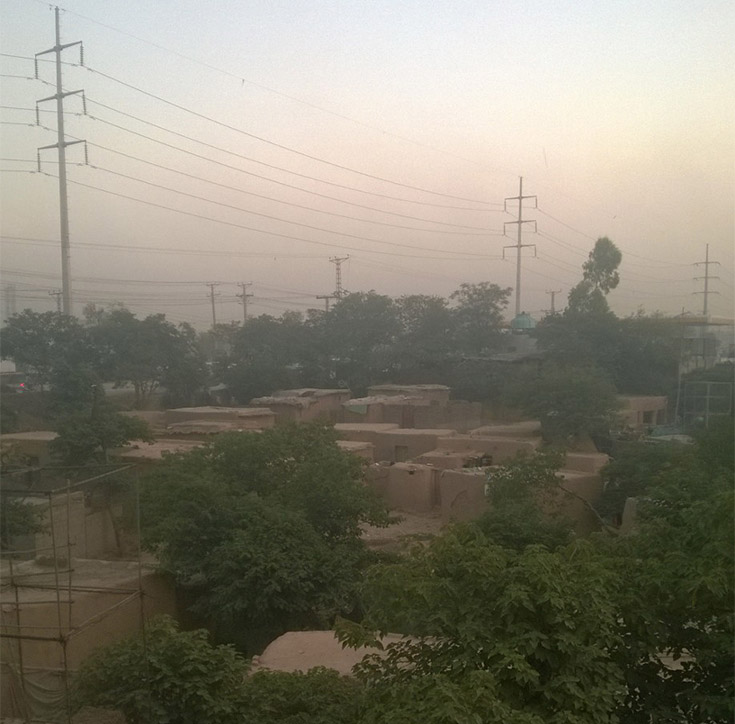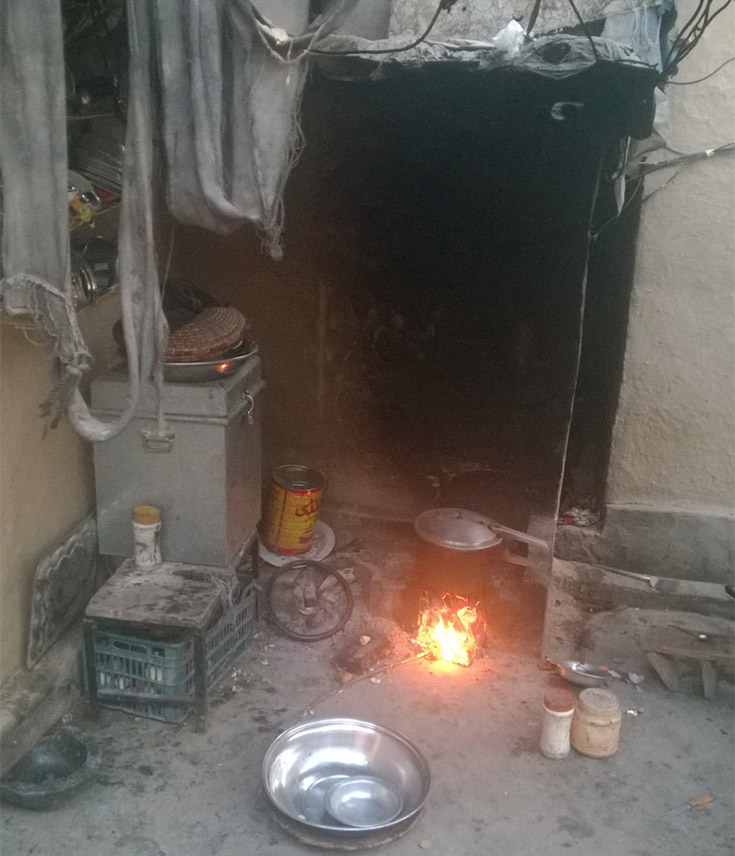Rendered homeless by slum clearance in Pakistan: A crisis in the making?
Pakistan already has an abundant supply of refugees and temporarily displaced people, so why it would chose to add to those numbers through its own actions is confusing to say the least, says Luavut Zahid. Here, she investigates the controversial slum clearance process and talks to people living under the threat of losing their homes.

Before it was torn down, the I/11 area was home to some of the poorest people in Pakistan. Yet, despite their low-income status, the people had managed to make their lives work. When the government took their electricity away, they figured out how to make solar panels work and began generating their own electricity. When the water lines were removed, they installed their own hand pumps. Every time a resource was stripped away from them, they found a way to provide for themselves.
Now their houses have been demolished.
Pakistan’s capital city was home to around 42 slums before the I/11 katchi abadi (slum) was torn down by the Capital Development Authority (CDA).
The main problem is not that the CDA chose to close the slums, but that it ignored its legal obligation to create a relocation plan for the dwellers. Under the country’s National Housing Policy of 2001, slum dwellers may only be removed once alternative accommodation for them has been secured.
When I reached out to the authority for a comment, a source told me – on condition of anonymity – that its plans for evictions around the city were being kept secret. “We announce one date in the media but actually act on another. We do this so that the people in the slums are not prepared and there is little backlash,” he said.

On whether there was a relocation plan in place, the source said that no such plan had been considered under the current action plan. “These people are from Afghanistan,” the source said while reiterating the myth that Afghans populate the area and need to be sent back home.
The reality is that the I/11 area was made up of Pakistani Pushtoons – an uneducated eye would categorise them the same as Afghans, because the two practically share the same ethnicity. Despite being termed an ‘Afghan Basti’ the area has had no Afghan inhabitants since the UNCHR resettled the few documented people who did live there. Duniya Aslam Khan of the UNHCR explained to me that the Afghans in the area had been moved to I/12, which is nowhere near the I/11 area. “We had an agreement for only the Afghans, we don’t work on internally displaced persons or Pakistanis in crisis in the area,” she said.
Despite facing heavy backlash from all corners of the media, the CDA seems unconcerned. In a press conference CDA Chairman Maroof Afzal said that removing illegal slums and encroachment was the body’s main responsibility and that the successful operation against I/11 proves its dedication. He said added that such slums should pop up in the city again.
The problem is primarily that the slums house a large number of people who perform many jobs around the city. From fruit sellers to domestic workers, from labourers to personal drivers, the city cannot run without these people. And without adequate help from the government there is little they can do to find homes they can afford – it’s no coincidence that they have spent the entirely of their lives in mud houses.

A person living in these areas makes between approximately US$ 30-100 a month, while a simple two-bedroom apartment can cost between approximately US$ 18,000 - US$ 42,000.
When the current government’s rule was ushered in a serious crackdown on terrorism became one of its main priorities. However, that crackdown has had a ripple effect. Around 60 slum dwellers were arrested during peaceful protests against their homes being torn down, and they are being tried under an anti-terrorism court.
A local political party has tried to help the people of the area by moving a petition in the Supreme Court of Pakistan against the operation. The petition highlights the obligations of the state to its people. Article 38D of the Constitution of Pakistan states that the country needs to provide basic necessities to all its citizens without discrimination of any kind. Despite this, and the law under the National Housing Policy, no efforts have been to help the people of the area.
The petition in the Supreme Court wasn’t the only reaction, even the Senate took notice of the demolitions and highlighted that the people living in the I/11 area had occupied it since the early 1980s. The land was then allotted by the CDA – despite knowing that there were people living there – in 1997. Since then several governments have come and gone, and most have tried to tear the slum down although the courts would always execute a stay order once the dwellers asked for help.
Other areas under threat
Before the houses were demolished in I/11, Luavut Zahid visited those who live in another area - the Miskeen colony and Musharraf colony – to talk to them about their lives, how they adapted to essential services being cut off and their fears for the future. Below, we publish that piece in full. A version of this article also appeared in Dawn
As soon as you enter the Miskeen colony and Musharraf colony areas in Karachi, Pakistan – two of over 40 slum areas that the Capital Development Authority (CDA) wants to raze to the ground after Eid – you are greeted by an interesting sight: solar panels.
And they are not few in number, almost all the homes have been fitted with these panels. While the middle class is yet to cozy up to the idea of solar power, what happened in these slums that caused them to adopt this green source of energy in such abundance?
Depending on who holding the reins to Pakistan’s democracy, the Miskeen colony and Musharraf colony in G-8/4 has gone from being illegal to legal and back. Despite its fair share of ups and downs, people who live here feel that the prominently Christian area has given them all that they need in life.
Nestled in between several different government apartments, this particular katchi abadi, although it is in a more precarious situation than most, has an interesting mix of people.
The area once had water, gas and electricity connections – some illegal and some unofficial – that were stripped from it as soon as the Pakistan Muslim League, the N (PML-N) government settled in.
What happens when you lose basic utilities? In the case of the katchi abadis in the capital, people take matters into their own hands.
Abdul Basit, a young man from the area, says that there is a trend for solar panels. “Over a year ago, when the power was first cut by the government, a man introduced the idea to others there,” he told me.
But who gave them the panels? “No one gave them to us. They are not funded by any person or NGO. People in the area had to find them and assemble them on their own. We get them at the wholesale market,” he said.
The area is slightly better built than most other katchi abadis, and is a sharp contrast to the I/11 area which is almost entirely constructed from mud and bricks. The I/11 has progressed much more with solar power because it is possibly the largest slum area in the city, but it is more organic in nature otherwise.
On one of the roof of Basit’s house lies an old worn out charpoy (a traditional woven bed) with panels fitted where its netting should have been. The people in this area waste nothing. Whatever little they have is used and then reused over and over again to sustain their lives.
Their solar panel is able to power around seven bulbs and three fans. “This is the solar charge controller,” Basit said while pointing at a black box hanging on his wall. The controller is connected to batteries that power everything in the house. “And this is how I charge my phone with it,” he said while flashing a happy smile.
What happens when these systems break down? “We figure things out ourselves. We didn’t know what we were doing when we first got them and lost money trying to fix our systems. Our panels were even stolen once… working on them has taught us what we need to know,” Basit said.
Basit’s father is a Benazir fan and loathes the current government. “These people are worse than pharaohs. We have lived here for 25 years, where will we go?” the old man said.
“We were left to live our lives in peace under Benazir’s rule. Then Musharraf was there but we were fine then too. Even when Zardari was ruling we didn’t worry for our homes.” He considers it a good thing that the current administration has cut the area’s power, saying the solar panels are better than the city’s electric supply.
And he isn’t wrong. With solar panels, people never have to worry about the lights going out. They have no pay no heed to any load shedding schedules and, ironically, enjoy uninterrupted power at all times.
But things aren’t always so simple. “In one night three solar panels were stolen from the colony a while ago,” Basit said and added: “We had to save money before we could buy this again. It can cost a minimum of Rs 25,000, which is a large amount.”
As we head on out of the home Basit’s father calls out to us: “Two of my sons work at newspapers, they’re trained in printing work. They are also journalists,” he said proudly.
His comments bring to light another frequent assertion: all manners of thievery, terrorism and evil manifest from the slum areas alone. In reality, most of the women work as maids while the men take up different jobs. Some are labourers, others are fruit sellers, guards, drivers, masons, janitors etc, and many work in the nearby government apartments and offices.
Riaz, the son of Sardaro bibi, an elder of the area, is a mason. That much is obvious in the way his house is structured. Of the many homes in the area, his is possibly the only one that has a stone pathway and strong walls. His work fetches him a good amount of money and he is able to provide for his wife and two sons many things that most in the area cannot afford.
“Solar power is good for us. I spent Rs 70,000 after saving money for a long while and now it supports our TV, the fans, the lights, everything – the only thing it can’t do is run the washing machine and for that I have bought a generator,” he explained. Riaz’s setup is the most expensive in his neighbourhood.
The solar panels fitted onto his roof are larger than anything else I’ve seen in the area. No one has else this kind of a setup. Downstairs he shows us his TV and music system while his two young sons follow.
His eight year old turned on the TV and said: “This is Charlie.” On the screen was Chaplin jumping around in. As an afterthought the boy clarified which Charlie and added, “Chaplin.”
Riaz wanted his sons to go to school. “They are like trees, they don’t understand anything. If I water them now only then will they grow,” he said.
While the elder son has long since quit education and has started helping his father with his masonry work, Riaz is bent on ensuring his younger son stays in school. “They refuse to take my elder son into the school because of his age, I wanted him to study and get educated. But I wanted to make sure that the younger one stayed in no matter what happened,” he said.
“He has tried to run away from school several times because of the way our children are treated but I send him back every time – he even hid his uniform once. It was hard but I just bought him a new one, I won’t give up on him,” he added.
The Pushtoon and Punjabi families that make up the areas are resourceful. The solar panels are only part of the story, people were also able to resolve their own water issues without anyone’s help.
“We have a lot of water pumps here and they are shared between families. Nine or 10 families will share one. There are more than 500 homes here so we can’t have different pumps for everyone,” explains Sardaro Bibi.
The area has such religious and ethnic diversity that I wonder, are there fights? Sardaro Bibi shakes her head: “Why would we fight? We don’t have much else except each other. What is the point in fighting over water or anything else?” she asked.
It is that sense of community that helps the people there more than anything else. When authorities show up with demolition equipment to tear things down everyone stands up against them in unison.
Earlier this month the Capital Development Authority (CDA) introduced its plans to demolish more than 40 slums areas from the capital city. What will become of the nearly 100,000 people living in these areas has not been touched upon.
Notices were issued to the people in the slums last year but nothing came of the notifications after the CDA faced resistance from the slum dwellers. This time is different. “After the CDA submitted its plan to the courts on June 28, some of its members visited some slum areas in the capital, but no proper notification has been issued to all the 42 slums,” Ammar Rashid of the All Pakistan Alliance for Kachi Abadis, the only organisation that is currently working with the people in the slums, informed me.
Rashid believes that the CDA is acting in haste, with no regard for the people that dwell in these areas. “I think they are acting against the basic norms of decency and the law itself. You can’t do something like this without reaching out to the people that live in these areas. There are hundreds and thousands of people involved. You need to speak to them and come up with long term solution… a proper plan,” he said.
“They just want to take the easy way out instead of trying to resolve the problem,” he added.
The slums are scattered all over the capital. Some rest on the outskirts of the city while others nudge right into the heart of heavily populated centres. What all of them have in common is that they are sitting on prime land, which can be sold for good money to the highest bidder.
For instance, the Miskeen colony and Mushrraf colony area alone sits in the G-8 sector next to a well maintained Markaz. A house here can cost around Rs 2.5 crore by some estimates. The I/11 area, which is much further away from the city centre, hosts two bedroom flats that can cost anything from Rs 24,00,000 to Rs 35,00,000.
However, none of the people that live in these areas know where they will go if their homes are razed to the ground to make way for bigger better homes.
“This is where we have lived all our lives… we don’t have a second option. The only thing we can do is try to fight back,” Basit’s father said wistfully.
Riaz agrees. “Where would you go if they took your home away? How do I answer this question?” he asked irritably.
Luavut Zahid, 13/08/2015